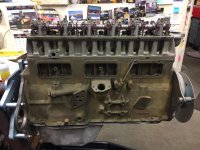Steve,
I didn't observe the sealant come out between the block and the sides, but I watched him physically strain to squeeze the sealant into the hole. He actually barked at me when I tried to talk to him while he was doing it, since he was concentrating on getting the sealant really forced into the holes. My engine hasn't marked its territory since the rebuild, that I've noticed, but I did notice a drop on the bellhousing drain hole when I was removing the gearbox.
I also tried something a little different when bolting the bellhousing to the gearbox: I put fresh copper washers--a Randy F. suggestion--under the bolt heads, with a grade 8 washer on the copper washer, and blue threadlocker on the (clean) bolt threads. There was no leaking around the bolts, which I believe can be a source of leaks out of the bellhousing. Of course, I installed a fresh first motion shaft seal as well.

 Hi Guest!
Hi Guest!

 smilie in place of the real @
smilie in place of the real @
 Pretty Please - add it to our Events forum(s) and add to the calendar! >>
Pretty Please - add it to our Events forum(s) and add to the calendar! >> 

